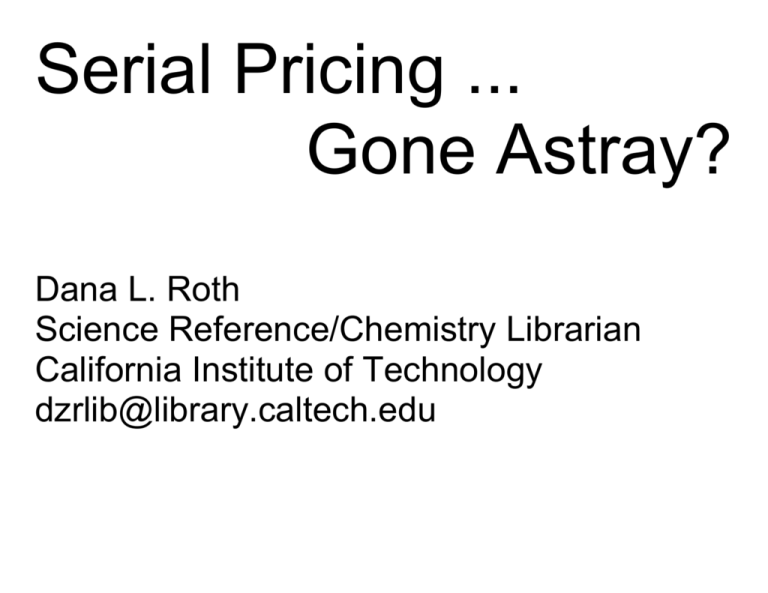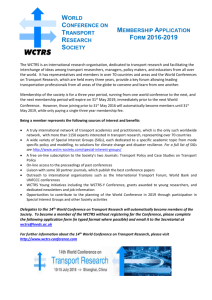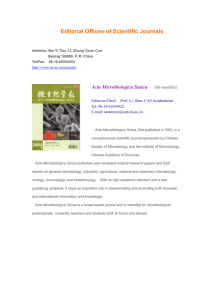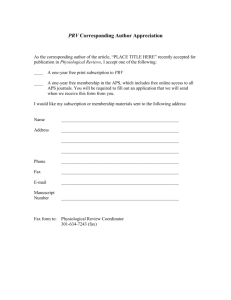Serial Pricing
advertisement

Serial Pricing ... Gone Astray? Dana L. Roth Science Reference/Chemistry Librarian California Institute of Technology dzrlib@library.caltech.edu Abstract: A comparison of serial pricing between commercial and society publishers suggests there is little relationship between price, Impact Factor, and physical content. Simple journal subscription price comparisons often have very little resonance with faculty members, even when their favorites appear on a listing of the most expensive titles. Previous studies on journal costs and effectiveness focused on fairly general subject areas and, for that reason, I feel they did not receive the attention they richly deserve. When discussing journal subscription costs and average article quality (as indicated by Impact Factors), with faculty members or administrators, it is very important to compare journals publishing the same subject / format information (e.g. research articles, letters, proceedings). Data will be presented that compare both journal subscription prices and cost/page + cost/page/impact factor (a measure of cost-effectiveness) for comparable journals. Raw cost/page/impact factor data is difficult to compare, unless one relates it to the unit costs given in grocery stores. Normalization is another technique and provides cost factors for the other journals. This quickly provides a more easily understood comparison of cost-effectiveness factors. In addition, the 'cost effectiveness' factors can be used to provide the equivalent non-commercial subscription prices for commercially published journals. This data, when presented in conjunction with locally produced cost/use data, can form the basis for an objective evaluation of a journal's local cost-effectiveness. Education of faculty members and library administrators to the disparities between pricing, use and costeffectiveness is essential for making rational serial cancellation decisions and helps avoid subscribing to grossly over-priced content. Organic Chemistry … Journal Cost and Pagination Comparison ORGANIC LETTERS SYNLETT TETRAHEDRON LETT. 2000 2005 $2300 $3361 46% pages 4269 5925 39% cost $ 575 $1165 103% pages 1860 3172 71% cost $8859 $11595 31% pages 10361 9060 -13% cost change net cng 7% 32% 44% Organic Chemistry … Journal Cost/Page/Impact Factor Comparison 2000 SYNLETT cost/page Impact Factor cost/page/IF ORGANIC LETTERS cost/page Impact Factor cost/page/IF TETRAHEDRON LETT. cost/page Impact Factor cost/page/IF 2004 $0.31 2.76 $0.36 2.74 0.11 0.13 $0.54 3.37 $0.62 4.20 0.16 0.15 $0.86 2.56 $1.14 2.48 0.34 0.46 change 16% -1% 15% 25% 33% -3% Organic Chemistry … Journal Cost/Page/Impact Factor - Normalized 2000 2004 SYNLETT cost/page/IF Normalized 0.11 1.00 0.13 1.00 ORGANIC LETTERS cost/page/IF Normalized 0.16 1.45 0.15 1.15 TETRAHEDRON LETT. cost/page/IF Normalized 0.42 2.90 0.59 3.69 This data suggests that for 2004, SynLett and Organic Letters have comparable cost-effectiveness, and are nearly 4 times a cost-effective as Tetrahedron Letters. Thus, for Tetrahedron Letters to be as cost-effective as SynLett in 2004, its subscription price should have been only $2986 rather than $11,017. Electrochemistry … Journal Cost and Pagination Comparison 2000 J. Electrochem. Soc. Electrochem. Acta J. Electroanal. Chem. 2005 change $761 52% cost $500 pages 4708 6080 29% cost $3239 $4436 37% pages 4716 5688 21% cost $7414 $10156 37% pages 3842 4466 16% net cng 22% 16% 21% Electrochemistry … Journal Cost/Page/Impact Factor Comparison 2000 J. Electrochem. Soc. cost/page Impact Factor cost/page/IF Electrochim. Acta cost/page Impact Factor cost/page/IF J. Electroanal. Chem. cost/page Impact Factor cost/page/IF 2004 change $0.11 2.3 $0.12 2.4 9% 4% 0.05 0.05 $0.69 1.6 $0.78 2.3 0.43 0.34 $1.93 1.7 $2.27 2.2 1.14 1.03 13% 44% 18% 29% Electrochemistry … Journal Cost/Page/Impact Factor - Normalized 2000 2004 J. Electrochem. Soc. cost/page/IF Normalized 0.05 1.00 0.05 1.00 Electrochim. Acta cost/page/IF Normalized 0.43 8.6 0.34 6.8 J. Electroanal. Chem. cost/page/IF Normalized 1.14 22.8 1.03 20.6 This data suggests that J. Electrochem. Soc. is nearly 7 times as costeffective as Electrochim. Acta and over 20 times as cost-effective as J. Electroanal. Chem. Thus, for Electrochim. Acta and J. Electroanal. Chem. to be as costeffective as JES in 2004, their subscription prices should have been only $620 rather than $4215 (Electrochim. Acta) and $468 rather than $9649 (J. Electroanal. Chem.). Are librarians inadvertent partners with commercial publishers in excessive serial pricing? Librarians tend to evaluate journal subscriptions on the basis of use, faculty interest and historical reputation. If this precludes annual cost/use evaluations, it will delay both cancellation and possible cessation of titles that no longer provide reasonable subscription prices. Gordon and Breach was an extreme example but individual titles, from some commercial publishers, clearly deserve annual re-evaluation. Wiley, for example, has some titles that grossly exceed reasonable cost: Surface and Interface Analysis Magnetic Resonance in Chemistry Biopolymers+Peptide Science Journal of Mass Spectrometry 2005 2005 2005 2005 $5970/1167p = $5.12/page $5395/1350p = $4.00/page $6995/1893p = $3.70/page $5615/1655p = $3.39/page These prices appear to be grossly excessive, even compared with similar journals from Elsevier: Applied Surface Science v. 235-251, 2005 J. Magnetic Resonance v.172-177, 2005 Peptides v. 26, 2005 Intern. J. Mass Spectrom. v. 239-248 2005 $6373/8210p = $0.78/page $3721/2002p = $1.86/page $3787/2712p = $1.40/page $4660/2211p = $2.11/page and especially with similar society published journals: Langmuir v. 21, 2005 Magnetic Resonance Med. * v.53-54, 2005 Biomacromolecules v. 6, 2005 J. Am. Soc. Mass Spectrom.** v.16, 2005 [*published by Wiley, **published by Elsevier] $2912/12414p = $0.24/page $1640/3069p = $0.53/page $905/3485p = $0.26/page $420/2084p = $0.20/page A related problem is the publication of conference proceedings and abstracts in presumably research journals. Conference proceedings potentially represent important research results and should be widely and quickly disseminated. However, due to their inherent nature (preliminary, speculative, establishment of priority) their archival value largely depends on developing these early research results into a peer-reviewed research article. Thus, the publication of proceedings papers in expensive, commercially published, research journals, often a year after the conference date, is obviously counter productive to their legitimate role in scholarly communication. This is especially true when they are peer-reviewed after the conference and no longer faithfully represent the paper presented at the conference. A more suitable venue for conference papers could be based on Caltech's experience in publishing and freely disseminating the proceedings of CAVITATION 2001. With the editorial assistance of the conference conveners, author submissions could be posted on the WWW for ~$50/paper. This cost is in stark contrast with the reported costs of $3000 (Springer) for open access peer-reviewed papers. In addition to Caltech's experience, the American Chemical Society has, for over 50 years, provided preprints of National Meeting papers of selected divisions for little more than the cost of reproduction. For example, Polymer Preprints 45(1), 2004 published 664 papers and 1132 pages at a library subscription price of $62.50, and was received at Caltech before the meeting was held. Polymer Preprints v.45(1), 2004 $62.50/664 papers = $0.09/paper $62.50/1142 pages = $0.055/page





